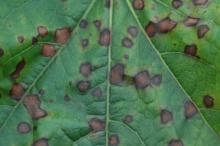Cause The fungus Phyllosticta ampelicida (formerly Guignardia bidwellii) has been found in Oregon. This is a slightly different form of the fungus that causes black rot of grape, which is not common in the PNW. Note that Phyllosticta parthenocissi would be the name of the pathogen on Virginia Creeper (P. quinquefolia).
Symptoms Necrotic leaf spots that generally are round but may be angular as they are constrained by large leaf veins. Spots may have a dark brown outline and then a chlorotic halo. Spots have lighter brown centers with black fruiting bodies (pycnidia) in the necrotic area. Leaves may have numerous spots and can result in defoliation.
Cultural control
- Remove and destroy fallen leaves before budbreak in the spring.
Chemical control Many fungicides that are effective against grape black rot have ornamental labels and may also be effective such as Compass, Eagle, Fore, Heritage and Spectracide Immunox.
- Armada 50 WDG at 3 to 9 oz/100 gal water. Do not use a silicone-based surfactant. Not for nursery or greenhouse use. Group 3 + 11 fungicide. 12-hr reentry.
- Myclobutanil 20 EW T&O at 6 to 12 fl oz/100 gal water plus spreading agent. May observe a PGR effect. Group 3 fungicide. 24-hr reentry.
Reference Luttrell, E.S. 1948. Physiologic specialization in Guignardia bidwellii, cause of black rot of Vitis and Parthenocissus species. Phytopathology 38:716-723.



